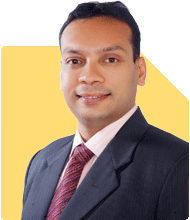Ramalingam Kalirajan |6504 Answers |Ask -Follow
Mutual Funds, Financial Planning Expert - Answered on Jul 06, 2024
He has an MBA in finance from the University of Madras and is a certified financial planner.
He is the director and chief financial planner at Holistic Investment, a Chennai-based firm that offers financial planning and wealth management advice.... more

Hi sir, I am 38 years old with 115000 salary With 20 lakh savings. I am planning for my retirement at 55.how can I plan for retirement by accumulating good amount of corpus .
Understanding Your Retirement Goals
Retirement Age and Time Horizon
You plan to retire at 55, giving you 17 years to accumulate a robust retirement corpus. This is a good timeframe to grow your wealth significantly.
Example:
Current Age: 38 years.
Retirement Age: 55 years.
Time Horizon: 17 years.
Having a clear timeframe helps in structuring your investments and understanding the growth potential of your funds.
Desired Retirement Lifestyle
Consider the lifestyle you wish to maintain post-retirement. Estimate your monthly expenses, factoring in inflation and any additional costs like healthcare or travel.
Example:
Current Monthly Expenses: Rs. 50,000.
Projected Monthly Expenses at Retirement: Rs. 1,00,000 (considering inflation).
This estimation will help in setting a target corpus that can sustain your desired lifestyle.
Building Your Investment Strategy
A well-diversified investment strategy is crucial for accumulating a good retirement corpus. Let’s explore the different avenues you can consider.
Equity Investments
Equity Mutual Funds
Equity mutual funds are a great way to invest in the stock market without needing to pick individual stocks. They offer the potential for high returns over the long term.
Advantages:
Growth Potential: Equity funds can provide substantial returns, outpacing inflation.
Diversification: Spread across various sectors and companies, reducing individual stock risk.
Professional Management: Fund managers handle stock selection and portfolio management.
Recommendation:
Allocate 60-70% of your savings and monthly investments to equity mutual funds. With a 17-year horizon, you can take advantage of the high growth potential of equities.
Types of Equity Funds to Consider:
Large-Cap Funds: Invest in well-established companies with stable returns.
Mid-Cap and Small-Cap Funds: Target growing companies with higher risk and return potential.
Multi-Cap Funds: Diversify across large, mid, and small-cap companies for balanced growth.
Debt Investments
Debt Mutual Funds
Debt mutual funds invest in fixed-income securities like bonds and government securities. They provide steady returns with lower risk compared to equities.
Advantages:
Stability: Lower risk, suitable for balancing a portfolio.
Regular Income: Ideal for conservative investments and generating steady income.
Liquidity: Easier to withdraw compared to long-term fixed deposits.
Recommendation:
Allocate 20-30% of your savings and monthly investments to debt mutual funds. They add stability to your portfolio, especially as you near retirement.
Types of Debt Funds to Consider:
Short-Term Debt Funds: Suitable for shorter investment periods (up to 3 years).
Long-Term Debt Funds: Better for longer horizons, providing higher returns than short-term funds.
Dynamic Bond Funds: Adjust based on interest rate movements, offering flexibility.
Hybrid Investments
Balanced or Hybrid Funds
Hybrid funds invest in both equity and debt, offering a balanced approach. They combine the growth potential of equities with the stability of debt.
Advantages:
Balanced Risk: Diversify across equity and debt, reducing overall risk.
Moderate Returns: Aim for moderate returns, lower than pure equity but higher than pure debt funds.
Flexibility: Fund managers can adjust the equity-debt mix based on market conditions.
Recommendation:
Allocate 10-20% of your savings and monthly investments to hybrid funds. They offer a balanced growth strategy with moderate risk.
Systematic Investment Plan (SIP)
Power of SIPs
Systematic Investment Plans (SIPs) allow you to invest regularly in mutual funds, promoting disciplined investing and benefiting from the power of compounding.
Advantages:
Disciplined Investing: Automates your investments, ensuring regular contributions.
Rupee Cost Averaging: Buys more units when prices are low and fewer when prices are high, averaging out the cost.
Compounding: Regular investments grow significantly over time due to the compounding effect.
Recommendation:
Start SIPs in the selected equity, debt, and hybrid mutual funds. Begin with Rs. 30,000 per month and increase by 10% annually.
Insurance Coverage
Health and Life Insurance
Adequate insurance coverage protects against unforeseen events and financial burdens.
Health Insurance:
Coverage for Medical Costs: Essential to prevent large out-of-pocket expenses.
Comprehensive Policy: Choose a policy that covers a wide range of medical needs.
Life Insurance:
Protection for Family: Ensures financial security for dependents in case of untimely demise.
Sufficient Coverage: Should cover debts, future expenses, and provide for your family's needs.
Recommendation:
Review and update your health and life insurance coverage regularly. Adequate insurance is a crucial component of a solid financial plan.
Review and Rebalance
Regular Portfolio Review
Reviewing and rebalancing your portfolio ensures it stays aligned with your financial goals and risk tolerance.
Advantages:
Stay on Track: Keeps your investments aligned with your retirement goals.
Risk Management: Reduces exposure to overperforming or underperforming assets.
Optimize Returns: Takes advantage of market opportunities while managing risk.
Recommendation:
Review your portfolio at least once a year. Adjust your investments as needed based on performance and changing goals.
The Power of Compounding
Long-Term Growth
Compounding allows your investments to grow exponentially over time, especially when you reinvest your returns.
Advantages:
Exponential Growth: Small, regular investments grow significantly over time.
Reinvestment: Earnings generate more returns, creating a compounding effect.
Long-Term Wealth: Can significantly increase your retirement corpus.
Recommendation:
Start investing early and stay invested to maximize the benefits of compounding. Regular SIPs and annual increments boost your growth potential.
Creating a Retirement Corpus
Estimating Your Corpus
To maintain your desired lifestyle post-retirement, estimate the amount you’ll need as your retirement corpus.
Considerations:
Longevity: Plan for at least 25-30 years post-retirement.
Inflation: Account for rising costs over time.
Lifestyle: Factor in the cost of maintaining your desired lifestyle.
Recommendation:
Work towards building a corpus that can provide a steady income stream, covering your estimated monthly expenses.
Generating Fixed Income
Post-retirement, convert your corpus into investments that generate a fixed monthly income to sustain your lifestyle.
Options to Consider:
Systematic Withdrawal Plan (SWP): Withdraw a fixed amount from mutual funds periodically.
Debt Instruments: Invest in debt funds or fixed deposits for regular interest income.
Hybrid Funds: Continue investing in hybrid funds for balanced growth and income.
Recommendation:
Plan a strategy to convert your retirement corpus into a steady income stream. Combine SWPs, debt funds, and hybrid funds for a reliable income.
Final Insights
At 38, you’re in a great position to build a substantial retirement corpus by 55. With disciplined investing and a strategic approach, you can achieve your retirement goals and secure a comfortable lifestyle.
Equity Funds: Start SIPs in equity mutual funds for high growth potential.
Debt Funds: Invest in debt mutual funds for stability and regular income.
Hybrid Funds: Include hybrid funds for balanced growth and moderate risk.
Incremental Investments: Increase your monthly investment by 10% annually to boost your savings.
Portfolio Review: Regularly review and rebalance your portfolio to stay on track.
Insurance Coverage: Ensure adequate health and life insurance to protect against unforeseen events.
Retirement Corpus: Focus on growing a corpus that can provide a steady income stream post-retirement.
Consult a CFP: Work with a Certified Financial Planner to tailor your investment strategy and make informed decisions.
By following these steps and staying disciplined with your investments, you can achieve a financially secure and comfortable retirement.
Best Regards,
K. Ramalingam, MBA, CFP,
Chief Financial Planner,
www.holisticinvestment.in
You may like to see similar questions and answers below
Ramalingam Kalirajan |6504 Answers |Ask -Follow
Mutual Funds, Financial Planning Expert - Answered on Jun 13, 2024
Ramalingam Kalirajan |6504 Answers |Ask -Follow
Mutual Funds, Financial Planning Expert - Answered on Jun 25, 2024
Ramalingam Kalirajan |6504 Answers |Ask -Follow
Mutual Funds, Financial Planning Expert - Answered on Jul 25, 2024
Ramalingam Kalirajan |6504 Answers |Ask -Follow
Mutual Funds, Financial Planning Expert - Answered on Jul 25, 2024
Moneywize |164 Answers |Ask -Follow
Financial Planner - Answered on Oct 05, 2024
Milind Vadjikar |317 Answers |Ask -Follow
Insurance, Stocks, MF, PF Expert - Answered on Oct 05, 2024
Milind Vadjikar |317 Answers |Ask -Follow
Insurance, Stocks, MF, PF Expert - Answered on Oct 05, 2024
Ramalingam Kalirajan |6504 Answers |Ask -Follow
Mutual Funds, Financial Planning Expert - Answered on Oct 05, 2024
Dr Dipankar Dutta |653 Answers |Ask -Follow
Tech Careers and Skill Development Expert - Answered on Oct 04, 2024
Krishna Kumar |377 Answers |Ask -Follow
Workplace Expert - Answered on Oct 04, 2024
Krishna Kumar |377 Answers |Ask -Follow
Workplace Expert - Answered on Oct 04, 2024
Krishna Kumar |377 Answers |Ask -Follow
Workplace Expert - Answered on Oct 04, 2024
Krishna Kumar |377 Answers |Ask -Follow
Workplace Expert - Answered on Oct 04, 2024
Krishna Kumar |377 Answers |Ask -Follow
Workplace Expert - Answered on Oct 04, 2024


























